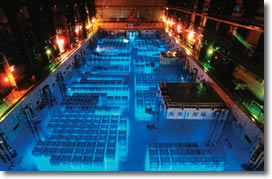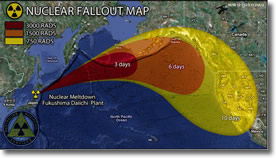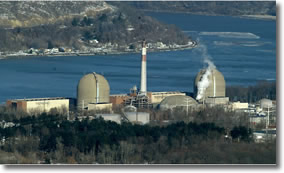Happy St. Patty's day. Erin go bragh. The Japanese are gonna need some of that luck-of-the-Irish .. seeing how Tokyo is the world's most populous city. Cuz now we hear reports that their spent fuel pools at Fukushima have gone DRY.
 That's what it sounded like all along, which is probably where they got all the hydrogen to blow the tops off those reactor buildings.
That's what it sounded like all along, which is probably where they got all the hydrogen to blow the tops off those reactor buildings.
[ Uncovered fuel produces hydrogen when the cladding overheats and begins to oxidize, and there's much more fuel stored in the SFP's than there is sitting in the reactor core. ]
The 9.0 earthquake (which reportedly continued to rock-n-roll for some 5 minutes, and exceeded the plant's structural design criteria based on its flawed seismic risk assessment) probably cracked the foundations of the aging plants and now the spent fuel pools can no longer hold water.
If true, that would be very bad. Worse than I could've ever possibly imagined. Cuz there's no pressure vessel (6-inch thick steel) surrounding the SFP .. like there is for the reactor core.
Whatever they are paying those guys, it aint enough. We're talking potentially lethal doses dealing with that problem. (You cant just walk up to the pool and look in to check water level, or you're dead.)
Conflict Between U.S. & Japanese Sources
There exists a surprising disagreement between the US NRC and those in Japan. The U.S. is saying "we saw" (via aircraft) that the pool is dry .. whereas those in Japan say "we saw" .. it's got water.
Uh, somebody is lying. Here's what I say » "Show me these photos."
I would be freaking out if I were working at a plant where the SFP is dry .. even more so than at a plant where we had lost core integrity. (Sentiment echoed by the U.N.'s Nuke chief.)
 The core has a 6-inch thick metal pressure vessel around it .. which will not only provide shielding, but keep most of the nasties inside.
The core has a 6-inch thick metal pressure vessel around it .. which will not only provide shielding, but keep most of the nasties inside.
You do not have that luxury with a SFP. Plus the source is so much BIGGER. You can store much more fuel in a SFP than you can in the core of a reactor.
Which means the exposure dose rates do not drop off as quickly with distance. There are different formulas for calculating dose-rates from a point-source, a line-source, and a plane-source.
[ Time, distance & shielding are the 3 ways we limit our exposure to radiation. ]
If you think about it logically, it makes sense. Think about how the nasty smell of garbage drops off with distance from different-sized sources. With an SFP, you are not merely standing next to a garbage can. Rather, you are AT the dump. =)
 First, if the spent fuel pools are dry, you dont want helicopters buzzing overhead, blowing the radioactive contamination to the four corners of the earth. And God forbid if anything were to happen to the engine while hovering over the pool.
First, if the spent fuel pools are dry, you dont want helicopters buzzing overhead, blowing the radioactive contamination to the four corners of the earth. And God forbid if anything were to happen to the engine while hovering over the pool.
The #1 question TEPCO needs to answer when/if they restore cooling » Is the pool holding water? (That's easy to tell.)
And the pilots are gonna get cooked (.. super high radiation levels) unless they fly high above, which will make it difficult for them to hit their target.
That was a stupid idea. Water cannons (from below) would've been better.
If I were king, I'd throw a big fat hose up-n-over .. into the pool. Maybe shoot it up there with a catapult or lift it with a crane .. and fill that suker with nuclear-grade concrete (.. add a little boron for good measure).
Use a crane to position a high-resolution camera way up high, so you can see wtf you're doing.
Then build a wall around the entire site .. and come back in a thousand years to see what kind of radiation levels we got. (Thank God for radioactive decay.)
What else can they do? Nothing. They're screwed. If they keep adding water to a leaking SFP, where is that water going? Into ground water? Into the ocean? [ The nuclear motto » dilution is the solution to pollution. ]
Put up a big sign » "The Fukushima Radioactive Waste Disposal Facility - Keep Out 'til 3011". Bury the whole place in concrete (nuclear sarcophagus) and chalk it up to a learning experience. Or bad luck.
[ Note that concrete weighs about two and one-half times MORE THAN WATER per unit volume. That means they'll only be able to fill the SFPs roughly one-third full .. to achieve the same weight-loading .. to avoid overloading the plant's structural design capacity. Rad civil engineering. ]
These pools were never intended for long-term storage of spent fuel. This has been an issue for many years now. "What're we gonna do when the pool is full?"
 Dry Storage Casks
Dry Storage Casks
Good time to buy stock in whatever company makes dry-storage casks. Those things are safe, but you have to wait ~5 years .. until the cell is "cool" enough (.. enough decay heat has diminished) .. before you can pull it out of the water and not have it cook itself.
I have worked with those casks. Basically lower it into the pool. (Gigantic, super heavy.) Drop in 4 cells (.. which never break the surface of the water). Put the lid back on and pull the cask out of water. Drain water out. Hose it down.
Spend a few days decontaminating by hand. (Stainless steel.) I dont recall hydrolazing these things.
If you hose it down with clean water while it's going INTO the pool, it's easier to decontaminate coming out .. cuz the clean water fills up all the little pores in the stainless steel.
[ I thought it was a stupid idea at first, but it really works. =) ]
I mean, you could drop this thing out of a plane at 30,000 feet and I dont think it would break. Tho you *would* have a big hole somewhere. =) Plus, they knock down the dose-rate to a surprisingly low level.
••• today's entry continues here below •••
 Does this new turn of events not make my post of Feb 15th seem even MORE trippy? (Seeing how I posted pictures of not only a spent fuel cell, but also a spent fuel pool. Too weird.)
Does this new turn of events not make my post of Feb 15th seem even MORE trippy? (Seeing how I posted pictures of not only a spent fuel cell, but also a spent fuel pool. Too weird.)
The owners of Fukushima should be conducting daily briefings .. on live TV. In nuclear power, vagueness is bad, cuz people tend imagine the worst. They need to be the picture of professional integrity & forthrightness. Not slimy & secretive.
If they dont know, they should say they dont know. (Tho not-knowing something in nuclear power is bad.) If they aint saying, it makes you think there's a REASON why they're not saying (.. and that reason aint good).
We want to know what they know for sure (current status). What they THINK they know (speculation). What they've done (actions). What they're planning to do (list of future actions).
How many spent fuel cells are contained in each pool? What is the status of these spent fuel cells? Who is helping? Biggest problem? Worst case scenario?
Best case scenario? What kind of dose are the workers receiving? What is the extent of their radiation monitoring? What dose & dose-rates are the heli-pilots receiving/seeing? What they (the utility) need .. regarding professional expertise & supplies?
Biggest question » where did all the water in the SFP's go? Those photos you see contain an optical illusion. Those pools at 40 feet deep.
 They've already done great damage to the entire nuclear industry. No need to make it even worse by being secretive.
They've already done great damage to the entire nuclear industry. No need to make it even worse by being secretive.
Update - Here's some info I found:
Unit 4 SFP contains 1,479 spent fuel rod assemblies that include 548 that were removed from the reactor only in November & December to prepare the reactor for maintenance, and these may be emitting more heat than the older assemblies in other storage pools.
It also says the fuel assemblies are "13-feet-high." Here's another quote from the same article:
Storage pools typically had a liner of stainless steel three-eighths of an inch thick, and that they rested on reinforced concrete bases. So even if the liner ruptured, "unless the concrete was torn apart, there's no place for the water to go."
 Yeah, that's my experience, too. So where did the water go? See here:
Yeah, that's my experience, too. So where did the water go? See here:
Even without recirculating water, it should take many days for the water in a storage pool to evaporate, nuclear engineers said.
So the rapid evaporation and even boiling of water in the storage pools now is a mystery, raising the question of whether the pools may also be leaking.
One last quote from page 2 of the same article, where they use the term "rods" for what I call "pins". Cuz they say (9th paragraph):
At Daiichi, each assembly has either 64 large fuel rods or 81 slightly smaller fuel rods. A typical fuel rod assembly has roughly 380 pounds of uranium.
64 = an 8x8 grid, while 81 = 9x9 grid. I would not call something thinner than the diameter of a pencil a "rod" .. but hey, I'm an American male .. who tends to reserve that term for items with a much larger girth. Sorry for any confusion.
Related » Nuclear Reactor Meltdown at Fukushima in Japan
For more along these lines, here's a Google search preconfigured for the query » nrc nuclear spent fuel pool dry fukushima
